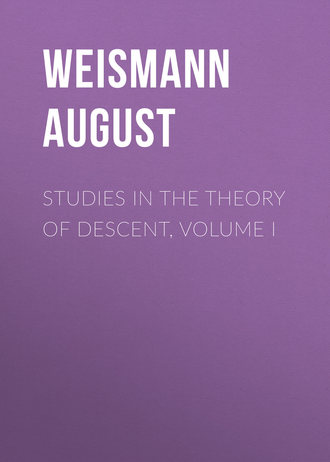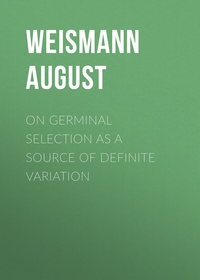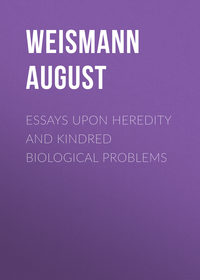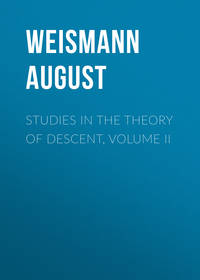 полная версия
полная версияStudies in the Theory of Descent, Volume I
132
[Andrew Murray called attention to this fact in 1859 (“Edinburgh New Philos. Journ.,” Jan., 1860, p. 9). This view is also corroborated by the fact that no internal feeders are green; see note 142, p. 310 and Proc. Zoo. Soc. 1873, p. 159. R.M.]
133
[Proc. Ent. Soc. March 4th, 1867; and “Contributions to the Theory of Natural Selection,” 1st ed., pp. 117–122; also Darwin’s “Descent of Man,” 2nd ed., p. 325. Among the most important recent additions to the subject of the colours, spines, and odours of caterpillars, I may call attention to a paper by Fritz Müller (“Kosmos,” Dec., 1877), the following abstract of which I communicated to the Entomological Society (Proc. 1878, pp. vi, vii): – “The larvæ of Dione Juno and Acræa Thalia live gregariously, and are brown in colour; they are covered with spines, but, being of dull colours, their spiny protection (which in the case of D. Juno is very imperfect) would not preserve them unless they were distinguished as inedible at the right time, and not after being seized, in accordance with the principles laid down by Mr. Wallace. It is suggested that the social habits of the larvæ which lead then to congregate in large numbers, make up for their want of colour, since their offensive odour then gives timely warning to an approaching enemy. The caterpillars of Colænis Julia and Dione Vanillæ are equally wanting in bright colours, but are solitary in their habits, and these species rest on the under side of the leaf when feeding. On the other hand, the caterpillars of Heliconius Eucrate, Colænis Dido, and C. Isabella, which are of solitary habits, and which freely expose themselves, are very gaudily coloured, and therefore most conspicuous. As examples of nearly allied larvæ, of which some species are gregarious and others solitary, Fritz Müller mentions Morpho and Brassolis, which are gregarious; while Opsiphanes and Caligo are solitary. The larva of Papilio Pompeius also is gregarious, and those of P. Nephalion, P. Polydamas, and P. Thoas are solitary… Fritz Müller sums up his observations by remarking that those caterpillars which live alone, and lack the bright colouring as a sign of offensiveness, must hide themselves; as those of C. Julia and D. Vanillæ. The spiny covering is much less a protection against birds than against smaller enemies; and they may, by the protective habit of living together, diffuse around themselves an offensive atmosphere, even to man, and thus gradually becoming shorter (as with D. Juno), the spines of these caterpillars become useless, and finally are altogether dropped.” See also Sir John Lubbock’s “Note on the Colours of British Caterpillars,” Trans. Ent. Soc. 1878, p. 239. Mr. Peter Cameron finds (Trans. Ent. Soc. 1880, pp. 71 and 75) that these remarks are also applicable to the larvæ of certain saw-flies. In 1877 Mr. J. W. Slater published a paper “On the Food of gaily-coloured Caterpillars” (Trans. Ent. Soc. 1877, p. 205), in which he suggested that such caterpillars might derive their distasteful qualities from feeding on plants containing poisonous or otherwise noxious principles. A much larger number of observations will be required, however, before this view can be accepted as of general application. A beautiful illustration of the theory of warning colours is given by Belt in his “Naturalist in Nicaragua,” p. 321. All the frogs found in the woods round St. Domingo are, with one exception, protectively coloured; they are of nocturnal habits, and are devoured by snakes and birds. The exception was a species of bright red and blue colours, which hopped about by day and made no attempt at concealment. From these facts Mr. Belt concluded that this species was inedible, and on trying the experiment with ducks and fowls this was found to be the case. R.M.]
134
See the essay “Über den Einfluss der Isolirung auf die Artbilding.” Leipzig, 1872, p. 22.
135
[See also preceding note 133, p. 294. R.M.]
136
[Eng. ed. The habit of hiding by day occurs also in those caterpillars which resemble the bark of their food-trees. Thus Catocala Sponsa and Promissa conceal themselves by day in crevices of the bark, and are, under these circumstances, only found with difficulty. Dr. Fritz Müller also writes to me that in Brazil the caterpillars of Papilio Evander rest in this manner in large numbers, crowded together into dense masses, on the trunks of the orange-trees, which they resemble in colour.]
137
“Über den Einfluss der Isolirung auf die Artbildung.” Leipzig, 1872, p. 21.
138
I am unfortunately not able to give exact numbers showing the relative proportions of the different forms, since I have never bred S. Convolvuli from eggs, nor C. Elpenor in sufficient numbers.
139
[With reference to C. Porcellus, see note 71, p. 188. R.M.]
140
[In the class of cases treated of in the foregoing portions of this essay, the external conditions remain unaltered during the lifetime of the caterpillar, but change of habit, and in some cases of colour, occurs when the insect has attained a size conceivable à priori, and are realized by observation, in which the environment itself may undergo change during the lifetime of the individual caterpillar. Thus, in the case of hibernating species, the colour which is adaptive to the autumnal colours of the foliage of their food-trees would not assimilate to that of the newly-opened leaves in the spring. I have already quoted (Proc. Zoo. Soc. 1873, p. 155) as instances of what may be called “seasonal adaptation,” the larvæ of Geometra Papilionaria, Acidalia Degenararia, and Gnophos Obscurata, and many more could be named. These species undergo a change of colour before or after hibernation, the change being always adaptive to the environment.
It has long been known that caterpillars which feed on flowers or on plants of variously-coloured foliage, in some cases partake of the colour of their food. See, for instance, Dr. L. Möller’s memoir, “Die Abhängigkeit der Inseckten von ihrer Umgebung,” 1867, and B. D. Walsh “On Phytophagic Varieties and Phytophagic Species,” Proc. Ent. Soc. Philadelph., vol. iii., p. 403. In 1865 Mr. R. McLachlan published a paper entitled “Observations on some remarkable varieties of Sterrha Sacraria, Linn., with general notes on variation in Lepidoptera” (Trans. Ent. Soc. 1865, p. 453), in which he gave many illustrations of this phenomenon. The larva of Heliothis Peltiger, according to Mr. Reading’s description (Newman’s “British Moths,” p. 438), is another case in point. In 1874 a number of instances were published by Mr. Thomas G. Gentry in a paper entitled “Remarkable Variations in Coloration, Ornamentation, &c., of certain Crepuscular and Nocturnal Lepidopterous Larvæ” (“Canadian Entomologist,” vol. vi., p. 85. See also W. H. Edwards’ description of the summer and autumnal larvæ of Lycæna Pseudargiolus; Ibid., vol. x., pp. 12, 13).The caterpillars of the Sphingidæ appear also in some cases to vary in a manner very suggestive of phytophagic influences. The observations upon S. Ocellatus recorded in the previous note (p. 241) may perhaps be interpreted in this sense. In order to get experimental evidence upon this subject, I may add that Mr. E. Boscher was good enough at my request to repeat his observations, and conduct some breeding experiments during the present year (1880). In the same locality as that previously mentioned, seven larvæ were found feeding on Salix viminalis, all of which were the bright green spotted variety; and in the same osier-bed six more were found on another species of Salix, two of these being the bluish-green variety, and the other four the bright green form. Unless we have here a local race, these observations, in connection with those of last year, tend to show that the light green form is associated with Salix viminalis. When found in the natural state feeding on apple, the caterpillar of this species is generally, perhaps invariably, the bluish-green form. In order to try the effect of breeding the larvæ ab ovo on distinct food-plants, a large number of eggs laid by a female Ocellatus in July were divided into three batches, one being supplied with Salix triandra, another with S. viminalis, and the third lot with apple. The experiment unfortunately failed in great part, owing to most of the larvæ dying off, three from the third lot only surviving; but these were all of the bluish-green form, which colour was shown by all the caterpillars of this batch from their earliest stage. The observation is thus so far successful, as it goes to support the view that the variety mentioned is associated with apple (and S. triandra?) My friend Mr. W. J. Argent informs me that he had a number of specimens of Sphinx Ligustri in his possession this autumn, some of which had been found on lilac and others on laurestinus, and he states that all those on the latter plant had the ground-colour distinctly darker than in those feeding on lilac. I learn also from Mr. W. Davis, of Dartford, that he found a number of these larvæ this year feeding on ash, and that they were all differently coloured to those found on lilac or privet, being of a more greyish-green. Another case of colour-variation in larvæ is that Emmelesia Unifasciata, specimens of which I have recently had an opportunity of examining, through the courtesy of Mr. W. Davis. This species feeds on the seeds of a species of Bartsia when the capsules are in various stages of growth, and (omitting details of marking) those caterpillars found on the green capsules were green, whilst those on the brown capsules were of a corresponding colour.On the whole I am inclined to believe that sufficient importance has not hitherto been given to phytophagic variability as a factor in determining larval coloration, and a large field for experimental investigation here lies open for future work. The obscure chemico-physiological processes which may perhaps be shown by such researches to lead to phytophagic variation, cannot, I am persuaded, produce any great divergence of character if unaided; but when such causes of variability play into the hands of natural selection variations of direct protective advantage to the species, we can easily see that this all-important agency would seize upon and perpetuate such a power of adaptability to a variable environment. (See Proc. Zoo. Soc. 1873, p. 158, and “Nature,” vol. xiv., pp. 329 and 330.) R.M.]
141
[In 1879 Mr. George Francis, of Adelaide, forwarded from the latter place a number of moths (a species of Anapæa) together with their larvæ (in alcohol) and cocoons (Proc. Ent. Soc. 1879, p. xvi), and in an accompanying note he stated that the male larva when living is of “a bright emerald green, with red and pink markings on the back, and yellow, black, and white streaks on the sides.” The male larva is described as being smaller than the female, and as possessing all the brilliant colours, the latter “having no red markings, but only white, yellow, and green, with a little black.” I was at first disposed to think that we might be dealing here with two distinct species having differently marked larvæ; but Mr. Francis this present year (1880) forwarded a large number of the living cocoons of this species, which I separated according to size, and, on the emergence of the moths (August), I found that all those from the small cocoons were males, and those from the larger cocoons females. There can be no doubt, therefore, that we have but one species in this case, the larva of which presents the remarkable phenomenon of sexual difference of coloration. As an analogous fact I may here mention the well-known case of Orgyia Antiqua, the larva of which differs in the colour of the tufts of hair according to sex. R.M.]
142
[I have already given reasons for suspecting that the colour of green caterpillars may be due to the presence of chlorophyll (or some derivative thereof) in their tissues (see Proc. Zoo. Soc. 1873, p. 159). This substance appears to be one of great chemical stability, and, according to Chautard, who has detected it in an unaltered state in the tissues of certain leaf-feeding insects by means of its absorption spectrum (“Comp. Rend.” Jan. 13th, 1873), it resists the animal digestive processes (Ann. Ch. Phys. [5], iii., 1–56). If this view should be established by future observations, we must regard the green colour of caterpillars as having been produced, when protective, from phytophagic variability by the action of natural selection; and the absence of colour in internal feeders, above referred to, is only secondarily due to the exclusion of light, and depends primarily on the absence of chlorophyll in their food. In connection with this I may adduce the fact, that some few species of Nepticula (N. Oxyacanthella, N. Viscerella, &c.) are green, although they live in leaf-galleries where this colour can hardly be of use as a protection; but their food (hawthorn and elm) contains chlorophyll. See also note 130, p. 293. Further investigations in this direction are much needed. R.M.]
143
[The same applies to Pseudoterpna Cytisaria, also feeding on broom at the same time of the year. The most striking cases of adaptive resemblance brought about by longitudinal stripes are to be found among fir and pine feeders, species belonging to the most diverse families (Hyloicus Pinastri, Trachea Piniperda, Fidonia Piniaria, &c., &c.) all being most admirably concealed among the needle-shaped leaves. R.M.]
144
The geographical distribution of the dark form indicates that in the case of this species also, the form referred to is replacing the yellow (green) variety. Whilst in the middle of Europe (Germany, France, Hungary) the dark form is extremely rare, in the south of Spain this variety, as I learn from Dr. Noll, is almost as common as the yellow one. I hear also from Dr. Staudinger that in South Africa (Port Natal) the dark form is somewhat the commoner, although the golden-yellow and, more rarely, the green varieties, occur there. I have seen a caterpillar and several moths from Port Natal, and these all agree exactly with ours. The displacement of the green (yellow) form by the dark soil-adapted variety, appears therefore to proceed more rapidly in a warm than in a temperate climate. [Eng. ed. Dr. Noll writes to me from Frankfort that the caterpillar of Acherontia Atropos in the south of Spain does not, as with us, conceal itself by day in the earth, but on the stems underneath the leaves. “At Cadiz, on the hot, sandy shore, Solanum violaceum grows to a height of three feet, and on a single plant I often found more than a dozen Atropos larvæ resting with the head retracted. It can easily be understood why the lateral stripes are blue when one has seen the south European Solaneæ, on which this larva is at home. Solanum violaceum is scarcely green: violet tints alternate with brown, green, and yellow over the whole plant, and between these appear the yellow-anthered flowers, and golden-yellow berries of the size of a greengage. Thus it happens that the numerous thorns, an inch long, between which the caterpillar rests on the stem, pass from violet into shades of blue, red, green, and yellow.”]
145
[For Mr. J. P. Mansel Weale’s remarks on the habits of certain ocellated S. African Sphinx-larvæ see note 129, p. 290. R.M.]
146
[Some experiments with the caterpillar of C. Elpenor, confirming these results, have been made by Lady Verney. See “Good Words,” Dec. 1877, p. 838. R.M.]
147
[The eye-spots on Ch. Nerii have thus been supposed by some observers to be imitations of the flowers of the periwinkle, one of its food-plants. See, for instance, Sir John Lubbock’s “Scientific Lectures,” p. 51. R.M.]
148
“On Insects and Insectivorous Birds,” Trans. Ent. Soc. 1869, p. 21.
149
Ibid., p. 27.
150
[Messrs. Weir and Butler inform me that they have not experimented with Sphinx-larvæ. R.M.]
151
[It appears that the nauseous character of these last butterflies is to a certain extent retained after death, as I found that in an old collection which had been destroyed by mites, the least mutilated specimens were species of Danais and Euplæa, genera which are known to be distasteful when living, and to serve as models for mimicry. See Proc. Ent. Soc. 1877, p. xii. R.M.]
152
[This bears out the view expressed in a previous note 129, p. 290, that the grotesque attitude and caudal tentacles are more for protection against ichneumons than against larger foes. R.M.]
153
These experiments, as already mentioned above, were not made with the common German lizard (Lacerta Stirpium), but with the large South European Lacerta Viridis.
154
Thus, Boisduval states of this caterpillar, which in Provence lives on Euphorbia esula and allied species: – “Its resemblance to a serpent, and its brilliant colour, permit of its being easily discovered.” This was written in 1843, long before natural selection was thought of.
155
Or some other extinct analogously-marked species.
156
[See Darwin’s remarks on the struggle for life being most severe between individuals and varieties of the same species “Origin of Species,” 6th ed. p. 59. R.M.]
157
[Compare this with Darwin’s remarks on “analogous variations,” “Origin of Species,” 6th ed., p. 125. R.M.]
158
“Zoologische Studien auf Capri. II. Lacerta muralis cærula, ein Beitrag zur Darwin’schen Lehre.” Leipzig, 1874. [The subject of colour-variation in lizards has been much discussed in “Nature” since the publication of the above mentioned essay; see vol. xix., pp. 4, 53, 97, and 122, and vol. xx., pp. 290 and 480. R M.]
159
“Über die Berechtigung der Darwin’schen Theorie.” Leipzig, 1868. See also the previous essay “On the Seasonal Dimorphism of Butterflies,” pp. 112–116.
160
[Mr. A. G. Butler has recently advanced the view that this family is not allied to the Sphingidæ, but is related on the one side to the Pyrales, and on the other to the Gelechiidæ. See his paper “On the Natural Affinities of the Lepidopterous Family Ægeriidæ,” Trans. Ent. Soc. 1878, p. 121. R.M.]
161
I am indebted to my esteemed colleague, Prof. Gestäcker, for the knowledge of this specimen.
162
Cat. Lep. East India Co., Pl. VIII.
163
Such a residue is distinctly visible in S. Ocellatus: see Fig. 70, Pl. VII.
164
[The question here also suggests itself as to why the dorsal line should not have been the primary longitudinal stripe, seeing that such a marking is almost naturally produced in many caterpillars by the food in the alimentary canal; or, in other words, why has not natural selection taken advantage of such an obvious means of producing a stripe in cases where it would have been advantageous? In answer to this I may state, that in large numbers of species the dorsal line has thus become utilized; but in the case of large caterpillars resting among foliage, it can be easily seen that light lateral (i. e. subdorsal) stripes, are more effective in breaking the homogeneity of the body than a dorsal line only slightly darker than the general ground-colour. Lateral lines are in fact visible from two directions of space. If a caterpillar thus marked be placed on a twig, these lines are visible when we look at the creature’s back or at either side. That the subdorsal are therefore the primary lines, as shown by Dr. Weismann’s observations of the ontogeny of many of the Sphingidæ, is quite in harmony with the view of their having been produced by natural selection. R.M.]
165
“Die Darwin’sche Theorie. Elf Vorlesungen über die Entstehung der Thiere und Pflanzen durch Naturzüchtung.” 2nd ed., Leipzig, 1875, p. 195.
166
[In the following species, already mentioned in previous notes, the oblique stripes are bounded at their upper extremities by a conspicuous subdorsal line: —Acosmeryx Anceus, Cram.; Sphinx Cingulata, Fabr.; Pachylia Ficus, Linn.; P. Syces, Hübn. In Pseudosphinx Cyrtolophia, Butl., the oblique white stripes, beautifully shaded with pink, run into the white pink-bordered dorsal line, so that when seen from above the markings present the appearance of the midrib and lateral veins of a leaf, and are probably specially adapted for this purpose. R.M.]
167
[The dorsal line as well as the oblique stripes is present in the caterpillar of Smerinthus Tartarinovii, Ménét.; and in Ambulyx Gannascus, Stoll., the oblique stripes are bounded above by a subdorsal line, as in the species named in the preceding note. R.M.]
168
Cat. Lep. East India Co., Pl. XI.
169
[Compare this with Darwin’s “Origin of Species” (1st. ed. p. 440), where it is stated that when an animal, during any part of its embryonic career, is active, and has to provide for itself, “the period of activity may come on earlier or later in life; but whenever it comes on, the adaptation of the larva to its conditions of life is just as perfect and beautiful as in the adult animal. From such special adaptations the similarity of the larvæ or active embryos of allied animals is sometimes much obscured.” R.M.]
170
[For Fritz Müller’s application of this principle to the case of certain groups of Brazilian butterflies see Appendix II. to this Part. R.M.]






